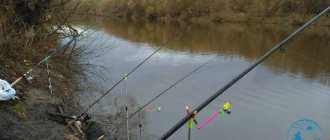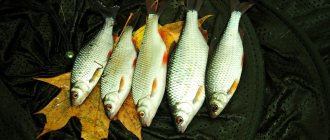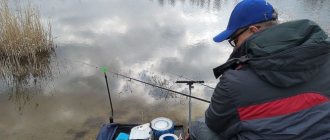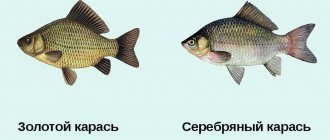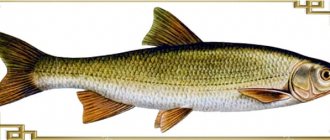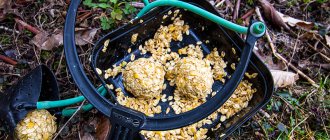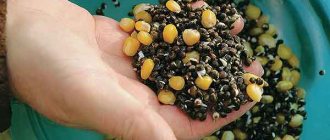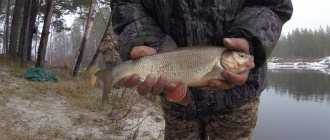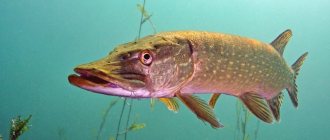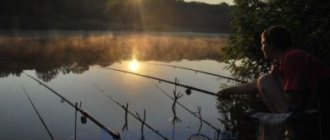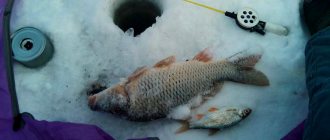Peculiarities of carp behavior in autumn
In autumn, the carp moves to its wintering grounds. In order for fishing to be most successful, you need to know where the autumn migration routes of schools of this fish are. You can search for carp trails on your own or get information from more experienced fishermen.
Those who don’t know where to look for fish can also be advised to try fishing at a depth not far from wintering pits.
Another important feature of the behavior of carp in autumn is that in cold water this fish is inactive and hardly feeds. Therefore, it is necessary to make adjustments to fishing techniques and tactics:
- it is important to understand what exactly carp are caught with in the fall, but at the same time use a small amount of bait;
- you need to be prepared for the fact that the carp will approach the fishing point only a few hours after the starting feeding;
- The pace of fishing in autumn is unhurried - bites are rare, and it’s also not worth re-casting the equipment often;
- In autumn, carp bite sluggishly and carefully, and in order not to miss the moment of hooking, you will need sensitive gear.
Groundbait, which is considered bait
Excellent results when fishing for carp in the fall can be achieved by using boilies. You can also use peas, pearl barley and other baits.
It’s worth trying to use each of the baits separately, as well as fishing with their combinations (“sandwiches”). For example, you can attach bloodworms and maggots or corn with bloodworms to the hook.
A good effect in the fall is obtained by treating baits with dips with strong odors - garlic, pepper, shrimp, crab and others.
Along with the boilie, traditional carp rigs adapted for river fishing came into the autumn carp fishing. The same rods, reels, and tackle are used. The principle of self-notching works in gear for catching carp with boilies in the fall. That’s why on the Volga they use heavier weights.
The boilie in this system is used with both positive and negative buoyancy. The size of such a boilie usually starts at 20 mm. But the taste is very difficult to guess. There are days when the autumn carp on the Volga favors fruity aromas. But this doesn't happen every day.
Therefore, when catching carp with boilies in the fall, you need to be thrifty and ready for any surprises. A supply of boilies with different flavors will definitely not become an obstacle to successful fishing, just like a supply of gear. The carp is active on the Volga at this time, and there will definitely be line breaks.
Fishermen in the Lower Volga consider oil cake a universal bait (and groundbait) that rarely fails.
In addition to cake, carp are also caught in autumn using boilies. Which is also one of the best attachments. Catching carp in the fall with baits has already been reviewed on our website.
Moreover, as bait, cake is combined with traditional baits of animal origin for catching carp - clams, crawlers, bunch of worms, crayfish neck. The combination of this bait with cereals, boilies, and beans can also be considered ideal.
Only some fishermen use cake as a bait. A briquette of cake is tied to a flat sinker using a loop, which, dissolving in water, begins to “dust”, releasing the aroma of sunflower into the water. The carp, sensing an interesting smell, comes to the bait and begins to suck up particles of the bait.
At least one of the small hooks must end up in the fish’s mouth along with the flow of water. Having been pricked by a hook, the carp abruptly leaves the place of bait, being caught due to the heavy sinker.
This method of catching carp using cake in the fall has one drawback - the more hooks the equipment has, the greater the chance that the hook will get caught on some snag.
Fishermen on the Volga solve this problem radically - they cover the hook tip with a foam ball. This, of course, increases the chances of a bite from other fish (bream, ide, chub), but bycatch in autumn carp fishing is better than empty waiting for a bite from such a capricious fish as carp. This is how it is to catch carp with cake in the fall. You can talk about it for a long time, but it’s easier to come to the Volga in the same September and try to catch this cunning fish yourself.
In addition to catching carp on the Volga, carp are caught in Russia and on Akhtuba. We have already considered this topic in detail, fishing for carp on Akhtuba in the fall, effective fishing.
On the Don, this fish is caught both from the shore and from a boat. Catching carp on the Don in the fall from a boat is considered a traditional, more convenient way of fishing, because it allows you to better examine the bottom at the fishing site. And it’s much easier to catch strong fish from a boat.
Bottom fishing gear is used both in fishing from the shore and in fishing from a boat.
When it comes to gear, in coastal fishing, carp (strong) feeders are usually used. To catch carp on the Don in the fall from a boat, fishermen use short (up to 2.5 meters) rods (most often spinning rods).
The tackle in all cases is a typical donka, the requirements for which can be summed up in one phrase: “The fewer knots, the better.”
You can watch carp fishing in the fall here. Catching carp in autumn video, enjoy watching.
At the beginning of autumn, carp responds well to baits of plant origin. It is caught on steamed grain, canned corn, and peas.
Closer to the cold weather, the carp slightly rearranges its diet. The October carp already bites on a bunch of worms and a crawler, but does not refuse plant baits. Local fishermen are advised to have in their arsenal dough made using various (preferably “sweet”) flavors.
Catching carp on the Don in the fall ends with the onset of severe cold. In November, the carp almost doesn’t bite anymore. It rolls down to the wintering pits and stays there until spring.
Bait for carp
The diet of carp is quite varied. It mainly feeds on animal food that lives in algae and silt. Its natural food is:
- bloodworm;
- mayfly larvae;
- water worms;
- caddisfly larvae;
- dragonfly larvae and other living creatures.
The carp is not averse to feasting on the fry. There are frequent cases of catching carp on spinning baits and artificial fish. And when fishing with edible rubber, catching a carp is generally considered the norm. But, of course, you should purposefully catch carp only with the most effective baits, which he is unlikely to deprive of attention or which will cut off bites from small fish.
The carp's favorite delicacy, bloodworms, will not bring you success when catching it. This bait will be eaten very quickly by small fish or your main catch will be perch or crucian carp. Catching carp involves a long wait and endurance. And such bait as bloodworms simply cannot lie on the bottom without attention for the required time. The carp simply will not have time to approach it; smaller representatives of the aquatic world will be ahead of it.
Effective baits for catching carp are:
- Crawling out. Crawl is an excellent bait for catching carp. This bait cuts off bites from small fish and is very much to the taste of carp. To catch carp using a crawler, a whole worm or even a bunch of several crawlers is used. To attach the crawler, you will need a fairly large hook with a long shank. The tackle must be ready for a bite from a large carp or even a catfish.
- Dung worm . To catch carp, you can use a bunch of dung worms. It is better to fish with this bait at night, when small fish will not eat the bait. In the morning and evening hours, such bait may not work on carp due to the interfering fines.
- Potato. This bait is probably used most often by anglers for targeted catching of carp. Apart from carp, no one will bite on potatoes in the river (except for rare random bites). Therefore, having planted a potato on a hook, you can sit quietly and wait for the long-awaited trophy to be caught. To catch carp, potatoes are used, boiled with the peel. Try not to overcook it, as it will then not stick well to the hook. It's better to let it be a little undercooked. Ready potatoes can be cut into cubes of the desired size directly while fishing. Usually the cubes are cut approximately 1x1 cm. You can also use small potatoes up to 3 cm in diameter and place them whole on the hook, after first piercing the peel in several places for a better aroma or peeling it.
- Pasta. Pasta is also one of the favorite delicacies of carp and a favorite bait of fishermen. Large pasta works best. You only need to boil them lightly, literally holding them in boiling water for a couple of minutes. Then the boiled pasta is laid out on clean paper, free of foreign odors. Dry it a little in this way and you have a carp bait ready.
- Corn and peas. These baits, which work great for carp, will also be effective when catching carp. You can use canned peas or corn, or make your own. You need to put several grains on the hook - 3-5 peas or corn. You can make a “sandwich” of corn and peas on one hook. Fishing with a hair rig is much more effective. When biting, the fish swallows the bare hook, so the probability of a successful hook is close to 100%. Hair rigs can be used not only when fishing with peas or corn, but also with the same pasta or potatoes.
- Perlovitsa. The natural food of carp is pearl barley shell. This mollusk resembles a sea mussel, the only difference being that it lives in fresh water and forms colonies on the bottom. It is difficult for the carp itself to get to the meat of the pearl barley due to the strong shell of the mollusk. By taking the pearl barley out of its shell and placing it on a hook, we have a great chance of getting a bite from the carp, which will happily indulge in this unique fish delicacy. The only thing you need to take into account is that pearl barley does not hold well on the hook, so it can be used in combination with other baits that will fix it on the hook - bread crust, worm, potato, etc.
A little about gear and bait
Catching carp with cake in the fall begins with choosing equipment.
When catching carp with cake in the fall from a boat, the most popular gear is bottom gear. For fishing from a boat, short (up to 2.5 meters) strong rods with a weight of up to 120 grams are used. It is better to use a carp reel, but a regular inertial reel will do.
The main line is nylon monofilament.
The equipment for catching carp with cake in the fall is not particularly complicated - a flat sinker is tied to the main line. Above the sinker there are four short (up to 7 cm) leashes made of soft materials. The hooks are small, with a short shank, but strong.
The sinker is flat and heavy.
In September
, of which there really is a lot in the Lower Volga, it becomes surprisingly capricious. Its behavior is largely due to the changeable autumn weather. September, of course, is still a fairly warm month, but the weather at this time becomes unstable.
The heat can even be replaced by strong cold winds within a day. Therefore, finding fish can be difficult. Even typical carp spots with depth differences and steep edges are not always effective.
Moreover, traditional, “sweet” bait also lures other fish species, those that, together with carp, are preparing for the coming winter (and often stand nearby in wintering pits)
Read more about how and what to catch carp in the fall on our website.
The optimal way to fish for carp in the fall is to fish with a feeder. This modern variety of bottom fishing rod provides interesting and productive fishing throughout the open water season, and autumn is no exception.
On the contrary, a feeder fishing rod with finely tuned equipment will allow you to notice the bite in time and make a hook, and this is very important in autumn fishing. At the same time, the feeder is much more accessible and versatile than a carp fishing rod.
Let's consider a feeder tackle option that will allow you to confidently pull out carp weighing up to 1.5 kg, and, if necessary, cope with fish weighing 3 or even more kilograms.
Bottom tackle for carp
Before you make a throw, you need to know the design of the tackle. It consists of several separate parts, let's look at each of them in more detail.
Rod or reel
This detail is important for ensuring long and accurate casting when fishing with all types of bottom rigs. The further we throw the bait, the larger the carp will take it. This rule applies to large rivers and lakes. The choice of fishing rod depends on the fishing method. If we go fishing from a boat, it is enough for us to have a rod with a length of 2 m.
But if you need to cast the bait at a distance of 70 meters, you will have to use a long rod with a different action. Although experts easily throw away gear with 100 grams. load 120–150 m with a simple steel spinning rod with a whip length of 2–3 m. Modern materials make rods lightweight and with better characteristics in terms of casting range and resistance to jerking loads.
The choice is purely individual; each angler decides for himself what funds he can allocate to purchase several fishing rods at the same time. But regardless of the materials and price - the minimum test is 100 g and a length of 3.6 m. How to throw a throw far, and most importantly accurately - you can answer this question after long hours of training and tackle that breaks while casting.
Coil
The casting distance directly depends on the reel if the casting method is used using a rod.
Basic requirement:
- power reserve;
- spool capacity;
- the presence of a reliable clutch;
- value for money.
Power is important when playing a strong and stubborn carp; it should not allow failures under heavy load. The friction clutch should not allow the line to tear during strong, sudden jerks. It gradually releases the line from the spool and dampens jerking loads. Catching carp on a bottom from the shore will require long casts, so the amount of line on the spool is important.
Cargo
Catching carp sets the angler the task of maintaining the following ratio:
- jerk load of the line when casting and retrieving prey;
- the total weight of the tackle and separately its sinker.
Many inexperienced fishermen prefer to increase the load and longingly watch the flight of the detached tackle into the distance. The weight of the entire structure should not exceed 120–130 g. Additional load on the line is created by snags on algae or branches when fishing for fish.
The maximum load will be needed only when casting long distances and catching carp in the current.
The problem of loading gear can be solved by giving it an ideal shape. In strong currents, it is not recommended to use pear-shaped weights; it is better to replace them with frame weights.
fishing line
For a novice fisherman, words about the power of carp make one want to set a thick line, but this rule only applies when catching huge specimens. To catch medium and large fish, it will be enough to use monofilament line or braided line 0.3-0.4 mm, but in this option the main load falls on the shock - the leader.
The length of the segment of this part of the equipment is up to 12, which allows you to absorb jerks when touching the edge of the edge and small snags on vegetation. The use of thick fishing lines is opposed to the increased windage of the equipment when casting feeders.
Leashes
For leashes, we recommend using nylon or braid with a cross-section of 0.14-0.18 mm. Such a line is invisible to fish in the water and will allow it to cope with increased loads.
Hooks
In addition to all the above details, it is important to choose reliable hooks specifically for this fish. We choose only the short forend. The hook tip must be made with notches. The springy material of the hook will improve the catchability of the equipment.
The choice of numbers depends on the size of the fish we are going to catch today. If we set up hooks for catching trophy carp, it is better to install hooks of at least number 5. For elastic bands and catching small specimens, it is enough to put number 2.
Feeders (springs)
You can install simple feeder feeders, which do their job in certain periods. To catch golden beauties, 2 feeder fishing methods are used:
- bait is thrown evenly throughout the fishing, in this case rectangular or triangular feeders or springs are used;
- The bait is introduced before fishing begins. In this option, after introducing a large starting amount of complementary food using a large feeder, it is replaced with a sinker.
Groundbait, which is considered bait
Since carp practically do not feed in cold water, a good autumn bait should awaken the potential trophy’s appetite, but not satiate it. This should cause the fish to take the bait on the hook.
As noted above, little bait is required - 2 kg is enough for one fishing trip. At the same time, it must be of the highest quality.
For fishing for carp in the fall, you can prepare bait with your own hands according to the following recipe:
- 1 kg of special feeder bait, for example, Sensas Super Feeder Big Fish;
- 0.5 kg fish and soy pellets;
- 200 g maggot;
- 1 can of canned corn.
The ingredients must be mixed and flavorings added. It's worth paying special attention to "spices" (garlic, pepper flavorings and the like), which usually work well in the fall on any white fish. Carp in cold water are perfectly attracted to anise and pineapple.
It is also worth considering that the use of bait brings good results in autumn carp fishing.
Successful
is closely related to the correct choice of fishing location and the correct bait.
fishermen most often
in the daytime, on sand spits with deep slopes.
The place is baited by throwing boilies to the chosen place using the traditional “cobra” for carp fishing. (Some fishermen use such an exotic device as a radio-controlled boat to deliver bait).
If you are planning to go fishing on Akhtuba, read a useful article for you, fishing for carp on Akhtuba in the fall.
Autumn fishing tactics
The fishing spot should be chosen on the advice of local fishermen. Searching for the treasured depths on your own is a long process and rarely effective. Catching carp on a feeder on the Volga requires certain tactics. Our local fishermen know the peculiarities of the local fishing, so you can always turn to them for advice or stay overnight by choosing the appropriate rate in the “About the base” section.
In autumn, underwater vegetation dies off and becomes practically invisible under the shore, so it is worth carefully inspecting the coastal areas and clearing them of any interference when fishing. A wire “cat” is suitable for this.
We leave such a distance between the tackles so that when biting and fishing the neighboring ones do not get confused. We coarsely feed the fishing area 2-3 times - we wait for some time. The fish fits onto the formed mud. After a 15-minute wait, we throw in the gear.
A sharp and strong bite requires the same hooking. We do not take prey when fishing in snags or flooded bushes. Evenly distribute the load from the reel to the rod. Pump out, slowly pull up the rod and reel in the fishing line. When catching such large fish, care must be taken when handling gear.
TAGS:
How to catch carp in the fall: tactics and technique
It is better to make the starting feeding small - five thimble feeders will be enough. In the fall, wait-and-see fishing tactics are used; the interval between re-casting the equipment should be significantly longer than in the summer. It can be, for example, 10-15 minutes.
The bait on the hook must be constantly alternated in order to find the one that is most attractive to the fish at a given time. Since the carp bites carefully in the fall, it is important not to miss the right moment and have time to hook.
In cold water, this fish offers almost no resistance when playing. The carp just needs to be slowly pumped out with a rod, reeling in the fishing line with a reel, and smoothly brought into the landing net.
You will receive even more useful and visual tips about catching carp in the fall in the video from the famous expert Alexey Fadeev. Enjoy watching!
Autumn carp fishing is not an easy task. However, even in these difficult times, you can remain with a rich catch. The ability to catch carp in cold water is a credit to any angler, as it is an indicator of the highest level of skill.
Have you ever caught carp in the fall and what gear did you use? Do you think it’s worth trying to catch carp in cold water at all, or is it better to limit yourself to summer fishing?

